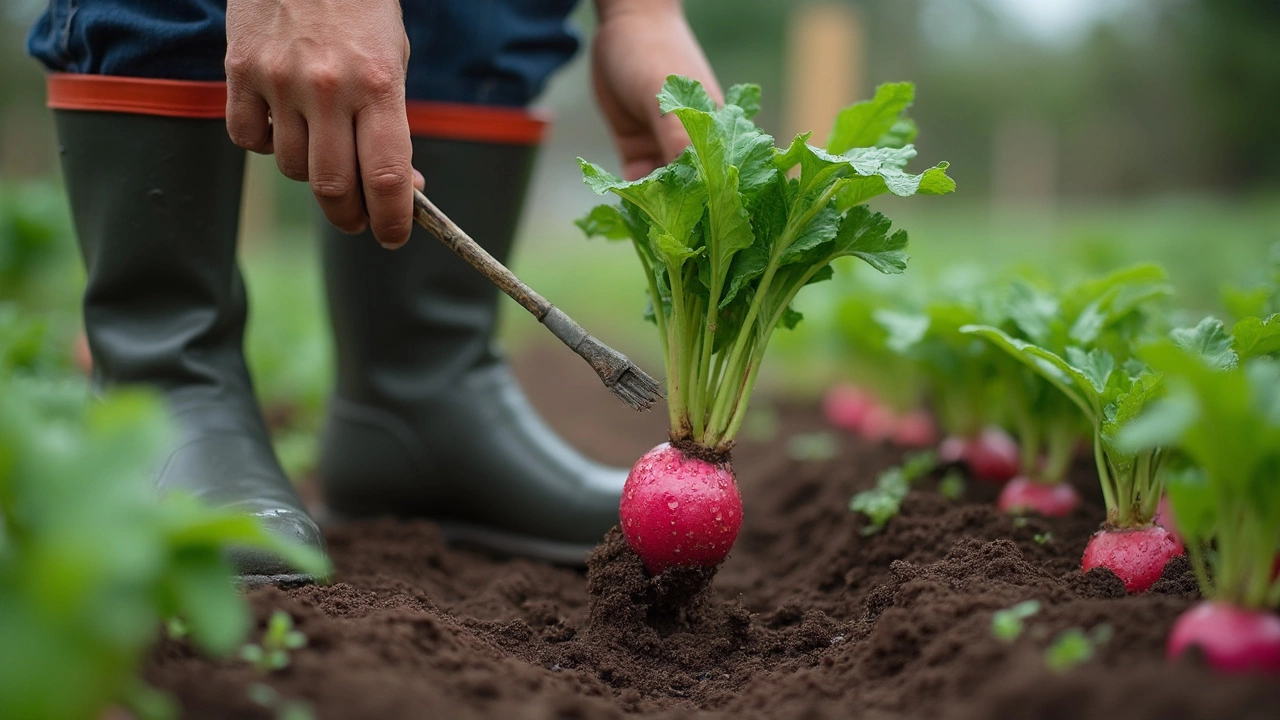If you want a vegetable that’s almost impossible to fail, go for salad greens—think lettuces, spinach, and arugula. These are the tried-and-true starters for anyone who swears they've got a black thumb. They don’t need much space, you don’t have to baby them, and you’ll see results fast. Lettuce, for example, was one of the first crops grown on the International Space Station, because it’s so reliable and quick. Can’t get much more foolproof than that.
All you really need is good soil and a spot with at least a few hours of sunlight. Don’t have a backyard? You can even plant them in a window box or a big pot by the door. Most salad greens sprout in less than a week, and you could be picking your first leaves in just about a month. There’s a reason even experts still plant these: they want easy wins too.
- Why Salad Greens Are the Top Choice
- How to Start Growing (Even Without a Garden)
- Common Mistakes and How to Dodge Them
- Creative Ways to Use Your Harvest
Why Salad Greens Are the Top Choice
So why do salad greens always get the spotlight when you ask about the easiest vegetable to grow? First off, they’re fast. With most lettuce and spinach, you can start snipping baby leaves in as little as 25 to 35 days. Compare that with other crops—carrots and tomatoes can take months to even get close to harvest. That speed means instant payoff, especially if you’re new to gardening and want to see a win right away.
Another big reason is versatility. Salad greens aren’t fussy about growing conditions. You can plant them outside, in containers, or even indoors on a sunny windowsill. They don’t need deep soil, fancy fertilizers, or constant attention. All you have to do is keep the soil damp (not soaked) and give them a patch of sunshine. If you forget to water for a day or two, they’ll usually bounce right back.
There’s also a huge variety. You’re not stuck with just the iceberg stuff from the store. Try leaf lettuce, butterhead, romaine, or even spicy arugula. Each one brings a totally different taste and crunch to the table, and most types handle cooler spring and fall temperatures without complaint. Plus, they’re naturally less prone to pests and diseases compared to things like cucumbers or squash, so beginners don’t waste time battling bugs or weird plant problems.
| Salad Green | Days to Harvest | Sun Needed |
|---|---|---|
| Lettuce | 25-40 | 4+ hours |
| Spinach | 30-40 | 4+ hours |
| Arugula | 20-35 | 4+ hours |
If you’re also thinking budget, this is where beginner gardening shines. A single seed packet costs less than a takeout salad and will keep you in greens for months. You just snip what you need, and the plant keeps growing, so you don’t even have to replant every time. Maximum results, minimum effort.
How to Start Growing (Even Without a Garden)
Got no backyard? Doesn’t matter. Easiest vegetable projects like salad greens fit nearly anywhere—kitchen countertops, window sills, balconies, you name it. These greens are designed for simplicity, so you’re not left stressing about space or gear.
Here’s how you can get started with beginner gardening in any small area:
- Pick Your Container: Grab a pot, window box, or even a big yogurt tub with holes poked in the bottom. Bigger containers hold water better, but even small pots can work for leafy greens.
- Use Quality Potting Mix: Bagged potting soil is best for containers—it keeps roots happy and drains just right. Skip garden soil from outside unless you want weeds or pests tagging along.
- Plant Your Seeds: Sprinkle seeds over the top, then cover lightly with more potting mix. Lettuces, spinach, and arugula all love this approach—no need to fuss over perfect rows.
- Water Gently but Often: Those seeds should stay damp, but not soaking wet. For apartment growers, aim for watering every other day, especially for shallow containers.
- Find the Right Light: A south-facing window works well. If natural light’s tough, even cheap LED grow lights from online stores work fine for leafy stuff.
Salad greens are super quick to sprout, sometimes in as little as 4 days. Keep things simple: no need for fancy fertilizers early on. Regular water and a bright spot get you 90% of the way there. Once green shoots pop up, thin them out a bit with scissors, letting the rest grow strong.
| Container Size | Greens You Can Grow |
|---|---|
| Small cup | Microgreens |
| 6-inch pot | Baby lettuce, arugula |
| Window box | Mixed greens, spinach |
| Large planter | Full-head lettuce, Swiss chard |
Don’t get stuck on perfection. The great thing about these low-maintenance crops is how forgiving they are. Even if your first round is a bit scraggly, you’ll get another shot every few weeks. That’s the beauty of growing salad greens—you eat, you re-plant, and you never stop learning.

Common Mistakes and How to Dodge Them
Even though salad greens are super easy, a few missteps can mess them up. Here’s what usually goes wrong and how to keep things on track for a crazy simple harvest.
- Planting seeds too deep: Salad greens like lettuce and arugula need to be barely covered—about a quarter inch of soil on top. If you bury the seeds, they’ll struggle to pop up. Dust them with soil, don’t dump a pile on top.
- Overwatering: It’s tempting to keep soil soggy, but soggy roots rot and seeds might not sprout. Keep the soil moist, like a wrung-out sponge, and let the surface dry a tiny bit before watering again.
- Letting them dry out: On the flip side, letting the soil dry so much that young seedlings wilt is a disaster. Daily check-ins work, especially during hot spells or if you’re using small pots that dry fast.
- No thinning: Lots of gardeners toss a bunch of seeds in one spot, then skip thinning. If seedlings are crowded, they fight for light, water, and space. Thin them to about a finger’s width apart once they’ve got a few leaves. Eating these thinnings is a bonus snack!
- Bad sun placement: If your beginner gardening setup is too shady, greens get leggy and weak. They work with as little as four hours sun, but more is better for strong growth. Move pots around if you need to wrangle more rays.
- Ignoring pests: Slugs and snails love fresh greens as much as you do. If you notice holes, check for them at night and pick them off. Coffee grounds, crushed eggshells, or copper tape help keep these slimy pests away.
| Problem | What Went Wrong | Fast Fix |
|---|---|---|
| Seedlings not sprouting | Planted too deep or soil too dry | Sow shallower, keep soil lightly damp |
| Yellow, floppy leaves | Overwatering or poor drainage | Let soil dry slightly, check pot holes |
| Holes in leaves | Pest attack (slugs, snails) | Use barriers and hand-pick pests |
Stick to these basics and your easiest vegetable will make you look like a pro, no matter your experience level. Every gardener trips up now and then, so don’t sweat the small stuff.
Creative Ways to Use Your Harvest
So you’ve got a pile of fresh salad greens on your countertop. Now what? There’s way more you can do with these low-maintenance crops than just toss a plain old salad.
- Mix Up Salads: Don’t stick to basics. Try blending your easiest vegetable picks—like lettuce, spinach, and arugula—with nuts, cheese, beans, or even leftover grilled chicken. A dash of olive oil and lemon beats bottled dressings every time.
- Smoothies: Spinach or baby greens disappear right into smoothies. Add a handful to your morning blend for extra vitamins without messing up the taste. One cup of fresh spinach packs about 56% of your daily Vitamin A.
- Wraps and Sandwiches: Salad leaves make healthier wraps than tortillas. Fill them up with seasoned rice, beans, or roasted veggies. They crunch better and don’t get soggy as fast.
- Sautéed Sides: Toss spinach or arugula into a hot pan with a little garlic and oil. They wilt but keep their flavor, pairing well with eggs or pasta dishes.
- Homemade Pesto: No basil? Greens like arugula or spinach make awesome substitutes. Blend them with garlic, nuts, cheese, and a splash of oil. Use on pasta, pizza, or roasted veggies.
If you end up with more greens than you can eat, here’s a pro tip: rinse, dry, then toss them in a freezer bag. While texture won’t be salad-worthy after thawing, frozen greens are perfect for soups or smoothies throughout the year.
| Type | Calories | Vitamin A (% Daily Value) | Vitamin K (% DV) |
|---|---|---|---|
| Spinach | 7 | 56% | 181% |
| Lettuce | 5 | 7% | 61% |
| Arugula | 5 | 11% | 21% |
Bottom line? These beginner gardening crops keep giving—on the plate and in the kitchen. Experiment with different combos. You might find you actually start craving salads, and that's a win for anyone who usually skips the greens at dinner.
